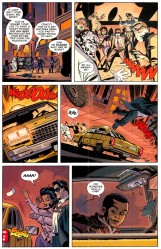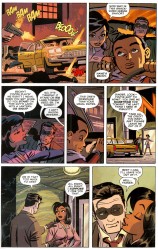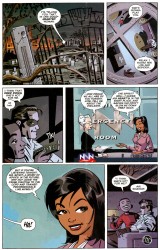I’m a little surprised at how much of my taste in comics has its origins in Daredevil. I got back into comics largely through buying copies of Frank Miller’s Daredevil Visionaries. I’d never read his run on Daredevil, and it was just what I needed to leapfrog onto the Bendis run, which led to other Marvel books, and so on. When I was a kid, Miller was my introduction to both grown-up comics and crime comics.
Visionaries. I’d never read his run on Daredevil, and it was just what I needed to leapfrog onto the Bendis run, which led to other Marvel books, and so on. When I was a kid, Miller was my introduction to both grown-up comics and crime comics.
There’s another aspect to this that I haven’t talked about, before. Before I was introduced to Grant Morrison’s work, before I discovered Joe Casey, Ann Nocenti introduced me to weird comics in the pages of Daredevil. I didn’t have many issues of her run, but I had some of the ones with Typhoid Mary and a few seriously off-kilter tales.



I’ve been re-reading Nocenti’s run on Daredevil, and it positively
leans. Her run is as much about how Daredevil is an overly violent fascist and a failure of a hero as it is about swashbuckling and dating. Nocenti got right up in the face of what it meant to pull on tights and beat up a criminal and did a pretty good job of breaking it down into its component parts. She has Murdock struggle with the thought of solving problems with his fists, forcing him to look at the effect he has on his environment. She introduced the Fatboys, a gang of youths who alternate between assisting Daredevil and getting into trouble. They follow his example and sometimes they get hurt. Sometimes they hurt people.
What’s so amazing about Nocenti’s run is that she followed up Frank Miller and David Mazzuchelli’s Born Again, one of the top five best superhero stories. Picking up the reins after two masters of the game told an amazing story must’ve been daunting, but Nocenti handled it well. She picked up the storylines they left, continuing on with a law practice-less, but happy, Murdock.
Brubaker and Bendis’s Daredevil is inextricably linked to the Frank Miller version. They’re continuing on in the same kind of story that he started back in the day. Nocenti, though, swerved right out of the gate. Her Murdock flipflops from confident to troubled, wrestling with his demons with the help of his girlfriend.
Typhoid Mary, whose origin story is collected in Daredevil Legends Vol. 4: Typhoid Mary , has been one of my favorite villains since I was a kid. Obviously, I didn’t get the Madonna (Mary)/Whore (Typhoid) complex that helps define her character or the subtle (?) feminism that Nocenti slipped in. There was just something about her that was, and is, endlessly interesting to me. She wasn’t like Batman’s villains, who were just crazy for the sake of being crazy. She wasn’t like Spider-Man’s villains, either, who were concerned with wealth. I don’t know that I had the mental capacity as a kid to articulate why I enjoyed reading about her so much. Mary was just undeniable.
, has been one of my favorite villains since I was a kid. Obviously, I didn’t get the Madonna (Mary)/Whore (Typhoid) complex that helps define her character or the subtle (?) feminism that Nocenti slipped in. There was just something about her that was, and is, endlessly interesting to me. She wasn’t like Batman’s villains, who were just crazy for the sake of being crazy. She wasn’t like Spider-Man’s villains, either, who were concerned with wealth. I don’t know that I had the mental capacity as a kid to articulate why I enjoyed reading about her so much. Mary was just undeniable.
The best word for her, as near as I can tell, is “uncomfortable.” Lesser writers will treat her as a generic crazy chick, Poison Ivy Plus Catwoman Minus Clothes. Nocenti, though, used her like a scalpel. She wasn’t a Bad Girl, but she was a bad girl. Typhoid Mary was a lot of issues distilled into one creature– religion, sexism, feminism, violence, and morality collided in her. She’s genuinely damaged goods, and troubling.
Mary is the easiest thing to point to when describing Nocenti’s run on Daredevil, but it’s just a part of the whole. There was the nuclear holocaust-obsessed son of a supervillain, the trials of the Fatboys, and the Inferno crossover. It’s creepy, but not creepy like a horror comic or a T&A book. It’s a crawling creepy, a book that makes you feel uneasy. Heroes who are far from perfect and entirely too human, a city full of people who refuse to be categorized into neat little boxes, the way a homeless woman tries to tell her husband where her gift is before she’s murdered by a villain… “that’s not right” sums it up pretty well.
Nocenti’s one of my favorite writers. No wishy-washy “one of my favorite female writers” or “throwback writers” or whatever. Just straight up, real talk, “favorite writers.” She’s good at what she does, and well worth seeking out. She’s spent the past few years out of comics, including filming a documentary, but she’s got a story in Daredevil 500 this August, with art by David Aja.
Good on her and good on Marvel for seeking her out. I’d like to see more work out of her in the future. I miss her voice in comics. Marvel should reprint more of her Daredevil. She did something special, and I think she’s been unfairly overshadowed by Miller’s run. Both are classic for different reasons.




























